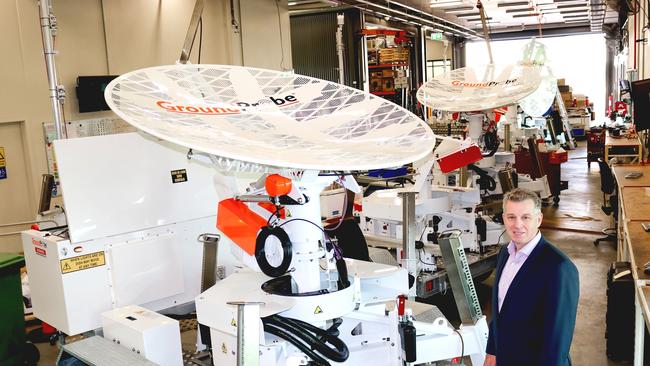Aussie scientists break new ground in mine safety
GroundProbe is rapidly becoming the shining jewel in Orica’s expanding business of hi-tech solutions for difficult problems.

Months before the massive pit wall collapse that all but buried Rio Tinto’s Kennecott copper mine in Utah in 2013, a small team of Australian geoscientists had already picked up minute movements in the rock face.
They sent a warning to Rio, ensuring the mine was cleared before 163 million tonnes of rock cascaded into the Kennecott pit in what is believed to be the biggest movement of earth, not caused by a volcano, in modern history.
The team of scientists worked for a small Australian company called GroundProbe, now owned by mining services giant Orica, and their information was so accurate Rio was able to issue a press release predicting the event seven hours before the rockfall.
Since then the GroundProbe team has successfully predicted more than 900 potential pit wall and tailings dam collapses at the mines its technology protects around the globe, and chief executive Brian Gillespie says the company and its workers are quietly proud of the fact they have never failed to spot an imminent collapse.
“And, of course, a lot of failures never happen, because if you pick them up you can often mitigate them, through engineering or draining the water, or reinforcing the structure,” he said.
GroundProbe, developed from Australian know-how and using hi-tech equipment designed and built in Brisbane, is now at the front line of Vale’s attempts to salvage its battered reputation in Brazil.
Its monitoring stations now cover all of the iron ore miner’s tailings dams, watching for tiny movements in the walls, to ensure there is no repeat of the tragedies early this year and at Samarco three years ago when sudden collapses took workers and local villagers by surprise, killing dozens and sparking an international outcry that has forced miners around the globe to look at the way they build and monitor their own tailings facilities.
GroundProbe’s mobile monitoring stations include hi-tech radar scanners and lasers, allied with high-definition cameras, that constantly sweep the walls of the facilities they watch, building a new three-dimensional image every few seconds. The data they produce is monitored by sophisticated algorithms that look for the smallest sign of movements in the ground — and can spot the difference between a falling leaf and a falling rock.
“At up to 5.6km our radar will tell us if something has moved a millimetre, or a sub-millimetre in some cases. So when you do rapid scans at tight resolution over wide areas, you can start to pick up movement and deformation. You put that into the mathematics and you can figure out if that movement is accelerating or decelerating and you can predict failures,” Mr Gillespie said. “Even though there’s nothing visible to the naked eye, and even though it might take weeks or months to happen, you can start to pick up acceleration even though the movement is only a millimetre at a time.”

Pit wall slippages are a regular source of fatalities in the mining industry — the “sudden” collapse of a wall at the Middlemount coal mine took the life of a Queensland mine worker only a month ago.
But Mr Gillespie says GroundProbe’s research shows pit wall failures are often months in the making.
“Typically you can pick up acceleration of movement months before it happens. The first movement may be sub-millimetre, but then it’s doubled that and then doubles again. Even though, to the naked eye, this thing has moved less than a centimetre over three or four weeks, you pick up the acceleration,” he said.
“You combine that with measuring a larger area and you can see scary things happening.”
If a potential collapse is picked up, GroundProbe can often give its clients weeks of notice, usually predicting the window of collapse to within a few hours.
In some cases, as with Kennecott’s massive collapse, workers can be pulled from the pit well in advance. In others, the miner’s own engineers can shore up the structure before a failure becomes inevitable.
In the case of Kennecott, Rio’s 800 mine workers were out of the pit well in advance of the failure, making the rockfall — which triggered small follow-up earth tremors across the region — “traumatic, but not tragic”, in the words of one commentator.
After beginning life as a doctoral thesis for four University of Queensland researchers 13 years ago, looking at ground penetrating radar, GroundProbe now provides services to more than 400 mines and tailings facilities across the globe.
Its manufacturing and scientific facilities remain in Brisbane, not far from where the company was founded. And, while the company runs a monitoring station in Indonesia, Mr Gillespie says the company strength is still its Australian base.
“One of the founders is still with us. All on one site in Brisbane, we have our mathematicians, our physics PhDs, our engineers, product developers, prototype guys and the production line in the factory, with a test facility 20 minutes away,” Mr Gillespie said.
“So our latest radar went from being an idea, to the first one being on site in South America, in six months.”
GroundProbe’s revenues are dwarfed by Orica’s traditional explosives, chemicals and agricultural divisions, but the company is rapidly becoming the shining jewel in Orica’s expanding business of providing hi-tech solutions to difficult problems.
Orica chief executive Alberto Calderon is expected to highlight GroundProbe’s growing contribution to Orica’s outlook at the company’s investor day today. The company paid $205m for GroundProbe early last year. Since then regulatory scrutiny of miners large and small around the globe has been heightened, suggesting the acquisition is likely to look like a bargain as GroundProbe’s business grows.


To join the conversation, please log in. Don't have an account? Register
Join the conversation, you are commenting as Logout